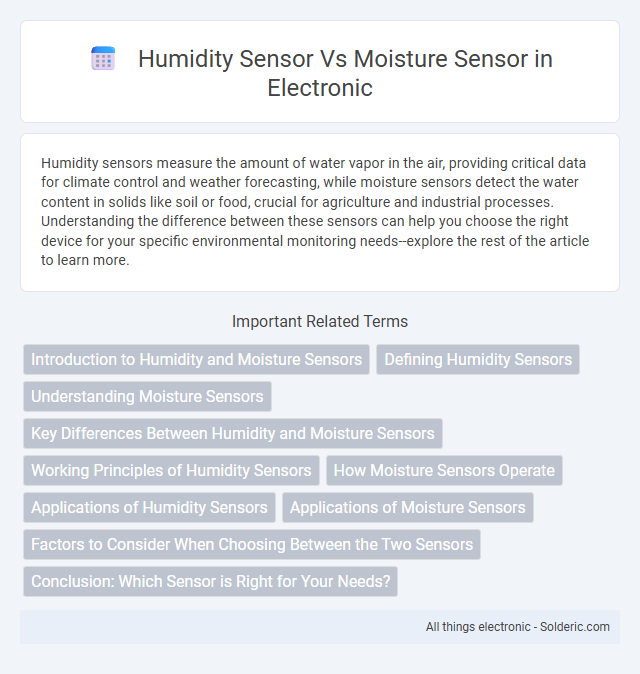Humidity sensors measure the amount of water vapor in the air, providing critical data for climate control and weather forecasting, while moisture sensors detect the water content in solids like soil or food, crucial for agriculture and industrial processes. Understanding the difference between these sensors can help you choose the right device for your specific environmental monitoring needs--explore the rest of the article to learn more.
Comparison Table
| Feature | Humidity Sensor | Moisture Sensor |
|---|---|---|
| Measurement Focus | Measures atmospheric water vapor (relative humidity) | Measures water content in soil or other materials |
| Common Types | Capacitive, Resistive, Thermal | Capacitive, Resistive, Tensiometer |
| Applications | HVAC, weather monitoring, industrial processes | Agriculture, gardening, soil analysis |
| Output | Percent Relative Humidity (%RH) | Volumetric Water Content or Soil Moisture Level |
| Accuracy | Typically +-2-5% RH | Typically varies; +-3-10% volumetric water content |
| Sensitivity | Detects air moisture changes quickly | Detects moisture within soil or materials |
| Installation | Non-contact or air-exposed placement | Inserted into soil or material |
| Power Consumption | Low to moderate | Low to moderate |
| Cost | Generally moderate | Generally lower to moderate |
| Environmental Impact | Measures ambient humidity, no direct soil impact | Direct soil contact; sensor durability depends on soil conditions |
Introduction to Humidity and Moisture Sensors
Humidity sensors measure the amount of water vapor in the air, providing data crucial for climate control, weather monitoring, and industrial processes. Moisture sensors detect the presence or concentration of liquid water in solid materials such as soil, wood, or concrete, commonly used in agriculture, construction, and manufacturing. Both sensors play vital roles in environmental monitoring and process optimization but differ fundamentally in their measurement targets and applications.
Defining Humidity Sensors
Humidity sensors detect and measure the amount of water vapor present in the air, providing critical data for climate control and weather forecasting. These sensors typically operate by assessing changes in electrical resistance or capacitance caused by moisture in the atmosphere. Understanding the specific function of humidity sensors is essential for optimizing your environmental monitoring and ensuring accurate atmospheric readings.
Understanding Moisture Sensors
Moisture sensors detect the water content in soil, plants, or materials, providing critical data for agriculture, gardening, and industrial processes. Unlike humidity sensors that measure water vapor in the air, moisture sensors offer precise information about liquid water presence, helping you optimize irrigation and prevent overwatering. Understanding moisture sensors enables better management of soil moisture levels, ensuring healthy plant growth and efficient water usage.
Key Differences Between Humidity and Moisture Sensors
Humidity sensors measure the amount of water vapor present in the air, providing data on atmospheric humidity levels, while moisture sensors detect the water content within solid materials such as soil or wood. Humidity sensors typically use capacitive or resistive elements to gauge relative humidity, whereas moisture sensors employ probes or dielectric methods to assess internal material moisture. The application focus diverges as humidity sensors are essential for climate control and weather monitoring, and moisture sensors are crucial for agriculture, construction, and material preservation.
Working Principles of Humidity Sensors
Humidity sensors detect the amount of water vapor present in the air by measuring changes in electrical resistance or capacitance of a hygroscopic material. These sensors often use materials like polymer films or metal oxides that absorb moisture, leading to measurable variations in their electrical properties. Your ability to accurately monitor environmental humidity depends on the sensor's sensitivity and responsiveness to these changes in vapor concentration.
How Moisture Sensors Operate
Moisture sensors detect the presence and quantity of water within a substance by measuring changes in electrical resistance or capacitance caused by water content. These sensors work by sending an electrical signal through the material and analyzing variations that occur due to moisture levels, providing precise data for applications like soil monitoring, manufacturing, and food storage. Understanding how moisture sensors operate can help you choose the right device for accurate moisture detection and control.
Applications of Humidity Sensors
Humidity sensors are widely used in HVAC systems to monitor and control indoor air quality, ensuring optimal comfort and energy efficiency. These sensors play a crucial role in agriculture by regulating greenhouse environments and preventing mold growth in storage facilities. Industrial processes also rely on humidity sensors for precise moisture control in manufacturing, protecting equipment and maintaining product quality.
Applications of Moisture Sensors
Moisture sensors find critical applications in agriculture for monitoring soil water content, ensuring optimal irrigation and improving crop yields. These sensors are essential in industrial processes to detect moisture levels in materials, preventing damage and maintaining product quality. In construction, moisture sensors help monitor concrete curing and detect water intrusion, safeguarding structural integrity.
Factors to Consider When Choosing Between the Two Sensors
When choosing between a humidity sensor and a moisture sensor, consider the specific environment and the measurement target: humidity sensors measure the amount of water vapor in the air, while moisture sensors detect the water content in solid materials like soil or fabric. Accuracy requirements vary; humidity sensors typically use capacitive or resistive methods for air vapor measurement, whereas moisture sensors often rely on conductivity or dielectric properties of materials. Additionally, factors such as response time, operating temperature range, and sensor compatibility with the application's electronics are crucial for optimal performance.
Conclusion: Which Sensor is Right for Your Needs?
Humidity sensors measure the amount of water vapor in the air, providing accurate atmospheric moisture readings, while moisture sensors detect the water content within solid materials like soil or plants. Your choice depends on the application: choose a humidity sensor for environmental or HVAC monitoring and a moisture sensor for agriculture or material-specific moisture detection. Understanding these distinctions ensures you select the right sensor tailored to your precise requirements.
humidity sensor vs moisture sensor Infographic

 solderic.com
solderic.com